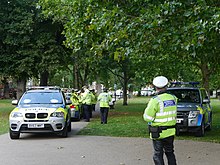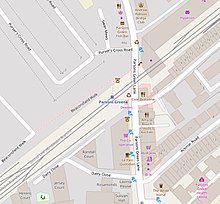The Moroccan Islamic Combatant Group, known by the French acronym GICM, was a Sunni Islamist militant organization that operated in Morocco, North Africa, and Western Europe. The organization's objective was to establish an Islamic government in Morocco.

Parsons Green is an above-ground London Underground station on the Wimbledon branch of the District line that opened in 1880. It is between Fulham Broadway and Putney Bridge stations and is in Zone 2. There are entrances on Parsons Green Lane and in Beaconsfield Walk. The station is a short distance north of the green itself. It was previously a train-operator depot, until functions were transferred to Earl's Court.
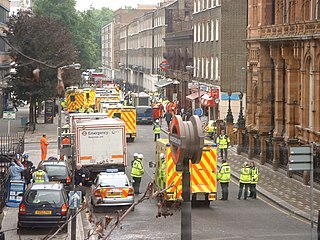
The 7 July 2005 London bombings, also referred to as 7/7, were a series of four coordinated suicide attacks carried out by Islamist terrorists that targeted commuters travelling on London's public transport during the morning rush hour.
On Thursday, 21 July 2005, four attempted bomb attacks by Islamist extremists disrupted part of London's public transport system as a follow-up attack from the 7 July 2005 London bombings that occurred two weeks earlier. The explosions occurred around midday at Shepherd's Bush, Warren Street and Oval stations on the London Underground, and on London Buses route 26 in Haggerston on Hackney Road. A fifth bomber dumped his device without attempting to set it off.
This is a list of deliberate attacks on the infrastructure, staff or passengers of the London Underground that have caused considerable damage, injury or death.
Terrorism in Australia deals with terrorist acts in Australia as well as steps taken by the Australian government to counter the threat of terrorism. In 2004 the Australian government has identified transnational terrorism as also a threat to Australia and to Australian citizens overseas. Australia has experienced acts of modern terrorism since the 1960s, while the federal parliament, since the 1970s, has enacted legislation seeking to target terrorism.
New Zealand has experienced few terrorist incidents in its short history and the threat is generally regarded as very low. However, the Security Intelligence Service (SIS) has warned against complacency. This article serves as a list and compilation of past acts of terrorism, attempts of terrorism, and other such items pertaining to terrorist activities within New Zealand. Significant acts of terrorism include the bombing of the Rainbow Warrior in 1985, an act of state-sponsored terrorism by France, and the Christchurch mosque shootings in 2019, a far-right attack which resulted in 51 deaths and 40 injuries.
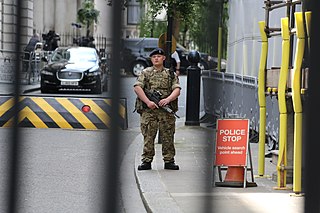
The United Kingdom Terror Threat Levels, often referred to as UK Threat Levels, are the alert states that have been in use since 1 August 2006 by the British government to warn of forms of terrorist activity. In September 2010 the threat levels for Northern Ireland-related terrorism were also made available. In July 2019 changes were made to the terrorism threat level system, to reflect the threat posed by all forms of terrorism, irrespective of ideology. There is now a single national threat level describing the threat to the UK, which includes Islamist, Northern Ireland, left-wing and right-wing terrorism. Before 2006, a colour-based alert scheme known as BIKINI state was used. The response indicates how government departments and agencies and their staffs should react to each threat level.
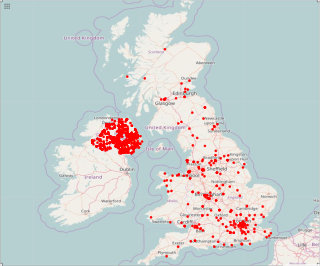
Terrorism in the United Kingdom, according to the Home Office, poses a significant threat to the state. There have been various causes of terrorism in the UK. Before the 2000s, most attacks were linked to the Northern Ireland conflict. In the late 20th century there were also attacks by Islamic terrorist groups. Since 1970, there have been at least 3,395 terrorist-related deaths in the UK, the highest in western Europe. The vast majority of the deaths were linked to the Northern Ireland conflict and happened in Northern Ireland. In mainland Great Britain, there were 430 terrorist-related deaths between 1971 and 2001. Of these, 125 deaths were linked to the Northern Ireland conflict, and 305 deaths were linked to other causes, including 270 in the Lockerbie bombing. Since 2001, there have been almost 100 terrorist-related deaths in Great Britain.
CONTEST is the United Kingdom's counter-terrorism strategy, first developed by Sir David Omand and the Home Office in early 2003 as the immediate response to 9/11, and a revised version was made public in 2006. Further revisions were published on 24 March 2009, 11 July 2011 and June 2018. An Annual Report on the implementation of CONTEST was released in March 2010 and in April 2014. The aim of the strategy is "to reduce the risk to the UK and its interests overseas from terrorism so that people can go about their lives freely and with confidence." The success of this strategy is not linked to total elimination of the terrorist threat, but to reducing the threat sufficiently to allow the citizens a normal life free from fear.

On 22 March 2016, two coordinated terrorist attacks in and close to Brussels, Belgium, were carried out by the Islamic State (IS). Two suicide bombers detonated bombs at Brussels Airport in Zaventem just outside Brussels, and one detonated a bomb on a train leaving Maelbeek/Maalbeek metro station in the European Quarter of Brussels. Thirty-two people were killed and more than 300 were injured. Three perpetrators also died. A third airport attacker fled the scene without detonating his bomb, which was later found in a search of the airport. A second metro attacker also fled, taking his bomb with him. The Islamic State claimed responsibility for the attacks.

Islamic terrorism in Europe has been carried out by the Islamic State (ISIL) or Al-Qaeda as well as Islamist lone wolves since the late 20th century. Europol, which releases the annual EU Terrorism Situation and Trend report (TE-SAT), used the term "Islamist terrorism" in the years 2006–2010, "religiously inspired terrorism" 2011–2014, and has used "jihadist terrorism" since 2015. Europol defines jihadism as "a violent ideology exploiting traditional Islamic concepts".

On 3 June 2017, a terrorist vehicle-ramming and stabbing took place in London, England. A van was deliberately driven into pedestrians on London Bridge, and then crashed on Borough High Street, just south of the River Thames. The van's three occupants then ran to the nearby Borough Market area and began stabbing people in and around restaurants and pubs. They were shot dead by Metropolitan Police and City of London Police authorised firearms officers, and were found to be wearing fake explosive vests. Eight people were killed and 48 were injured, including members of the public and four unarmed police officers who attempted to stop the assailants. British authorities described the perpetrators as "radical Islamist terrorists".
On 19 June 2017, an Islamophobic terrorist attack occurred in Finsbury Park, London, England, when a van was intentionally driven into a crowd of Muslim pedestrians near the Muslim Welfare House, 100 yards (90 m) from the Finsbury Park Mosque, causing 1 death and injuring 11 people. The attack was found to be motivated by Islamophobia.

On 20 June 2017, a terrorist bomb caused a small explosion at Brussels-Central railway station in Brussels, Belgium; there were no casualties. Soldiers patrolling the station subsequently killed the suspect with three to four shots, according to eyewitnesses. The perpetrator was Oussama Zariouh, a 36-year-old Moroccan national who lived in the Molenbeek municipality and who had assembled a defective explosive device.
The insurgency in Bahrain is an ongoing insurgency by militant groups, part of the Bahraini Opposition, supported by Iran, to topple government of Bahrain.

On 14 August 2018, three people were injured when a silver Ford Fiesta hit them near the Palace of Westminster, London, England. The car then went on to crash into the separation barrier of the pavement situated between St Margaret Street / Abingdon Street and Old Palace Yard. The Metropolitan Police responded within seconds and arrested the driver, Salih Khater, without further incident. An ambulance immediately behind the Ford stopped and gave assistance to the injured. Khater was subsequently found guilty of two counts of attempted murder and sentenced to life in prison.

On 14 November 2021, a taxi carrying a passenger arrived at the main entrance of Liverpool Women's Hospital in Liverpool, England. An improvised explosive device carried by the passenger ignited, killing him and injuring the driver. The police later declared it to be a terrorist incident; the perpetrator had been refused asylum in 2014, lost appeal in 2015, and lived in England until his attack.
